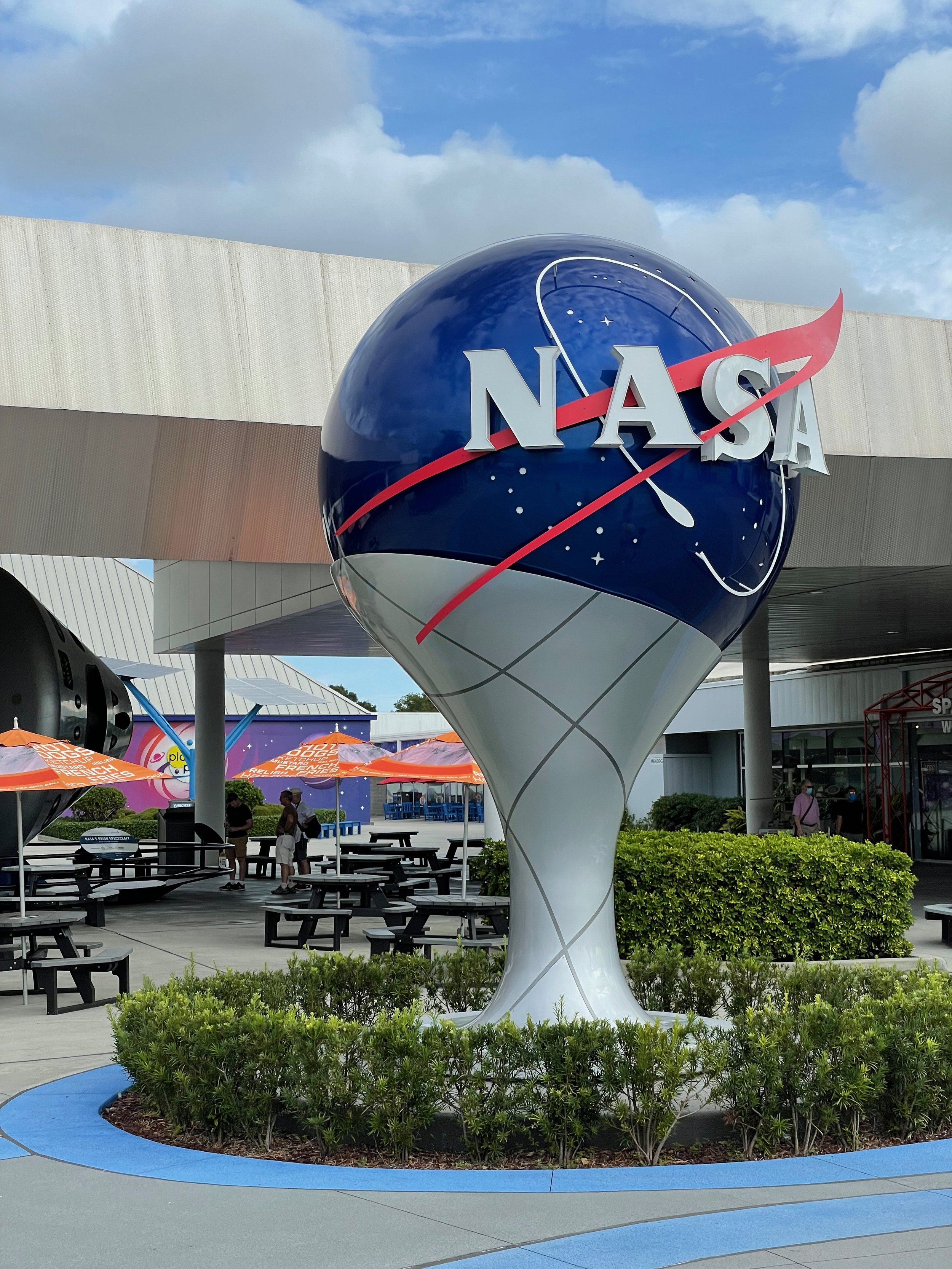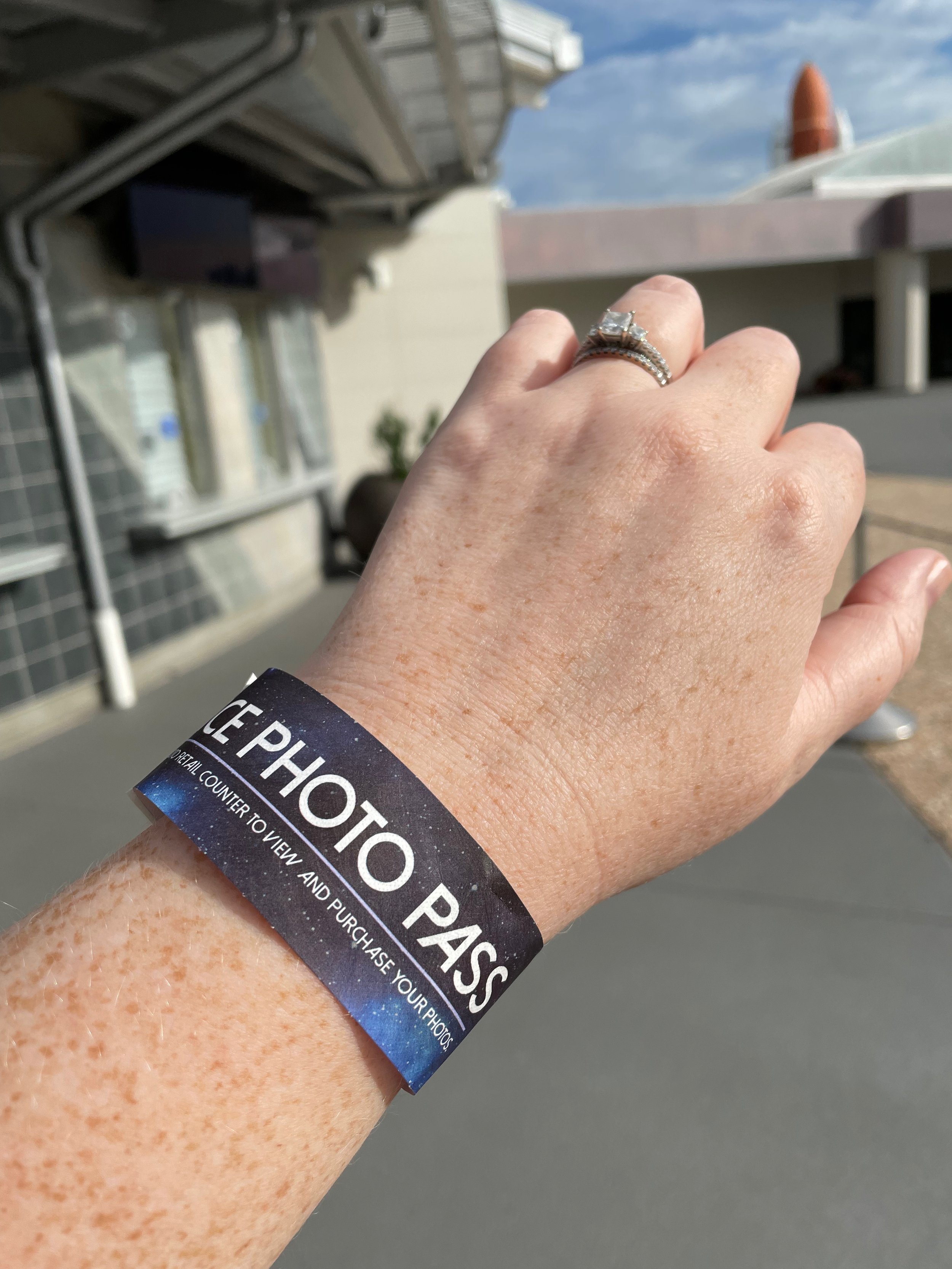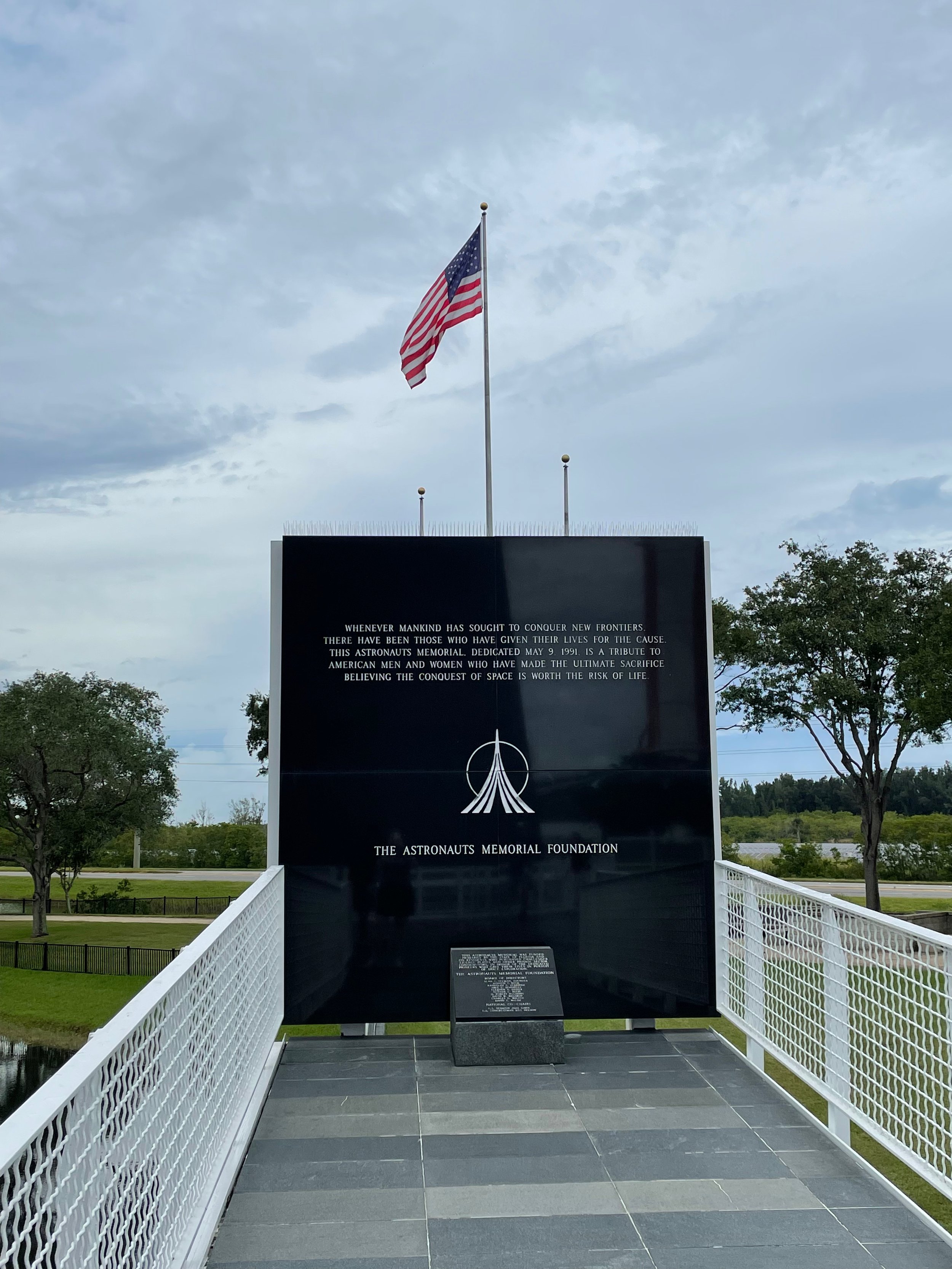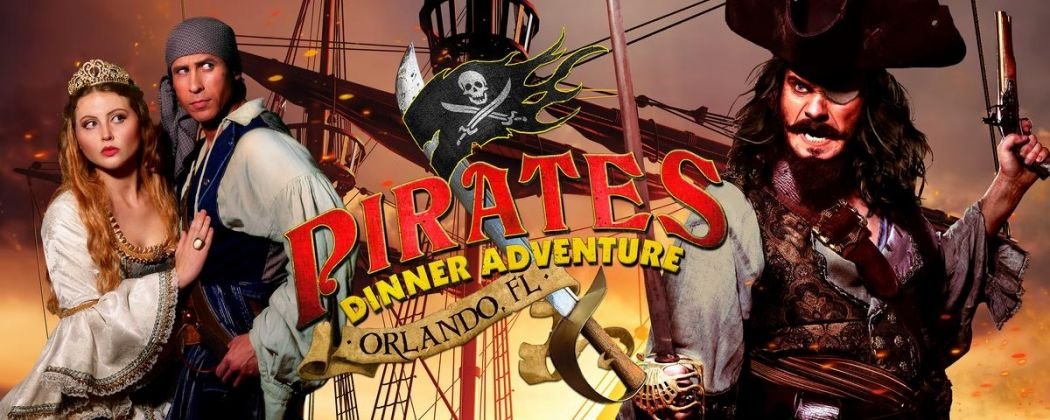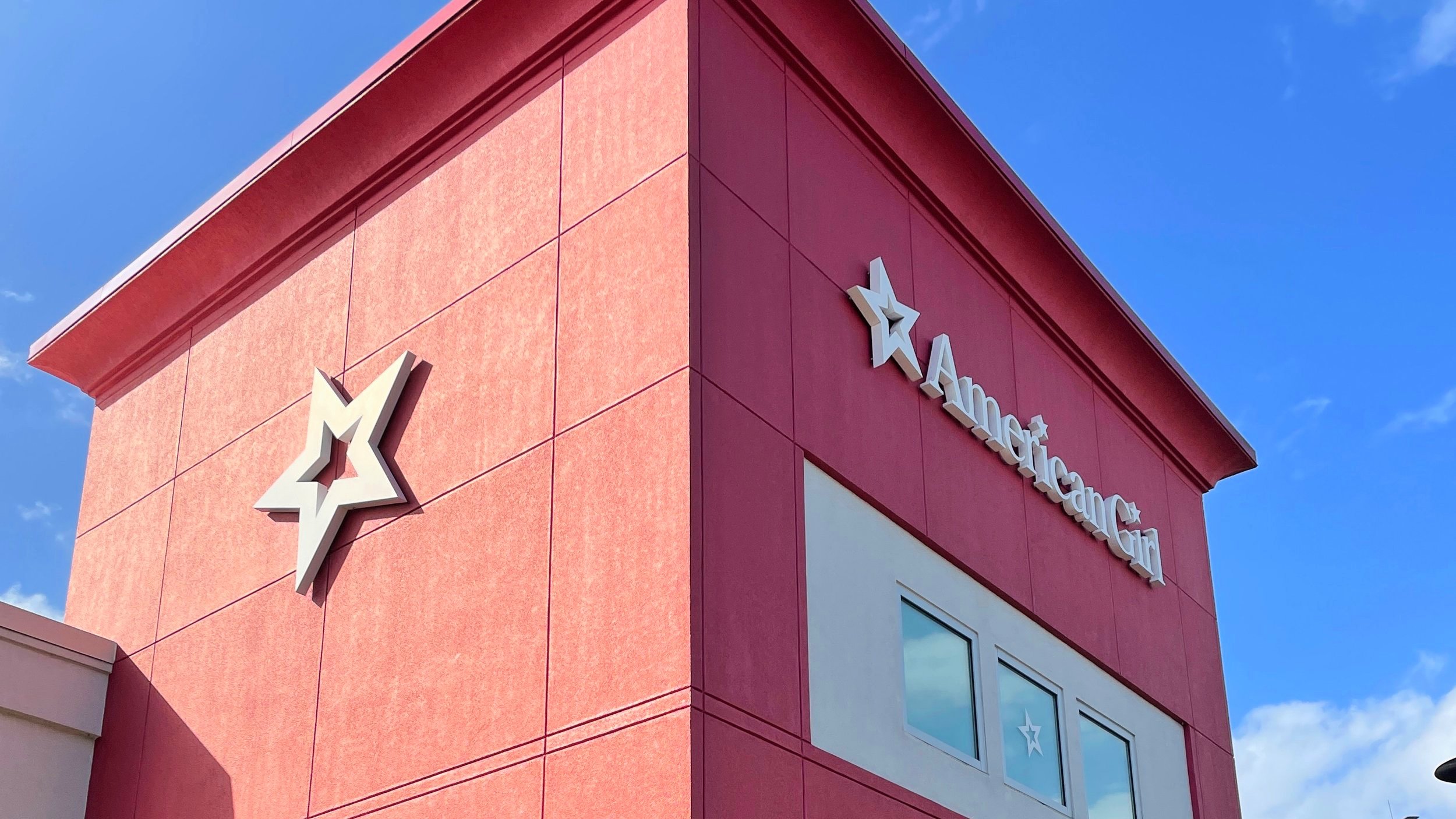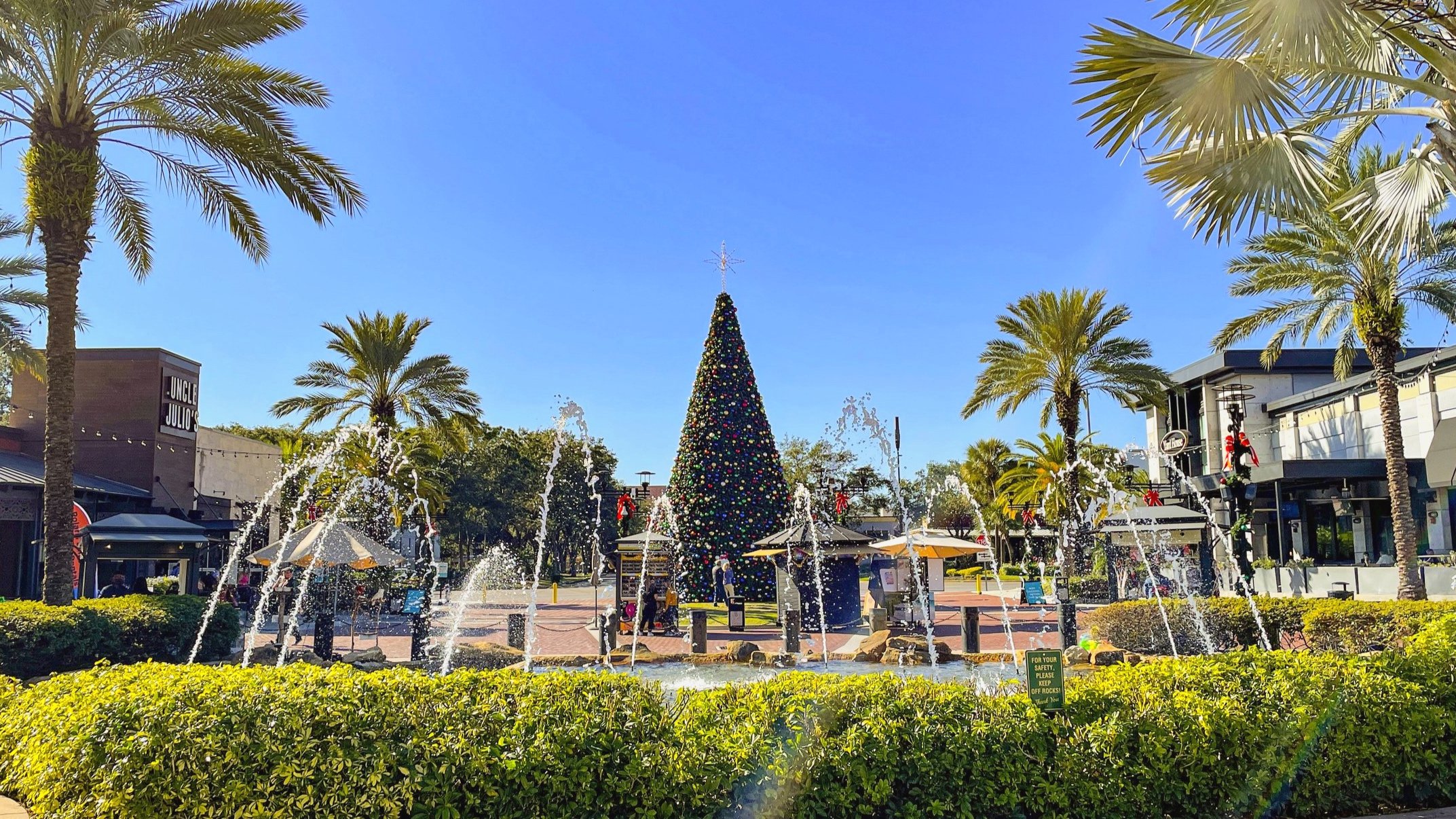Disclaimer: this post is in partnership with Kennedy Space Center. We were provided a complimentary visit but all thoughts are our own.
While not in Orlando, there is an attraction that is well worth the approximately 1 hour drive: The Kennedy Space Center Visitor Complex. This educational attraction celebrates America’s Space program from the early days post World War II, through the Space Shuttle Program, and the next steps to Mars. While Julie had visited as a small child, Andrew (an aviation enthusiast) had never been. We were excited to mix in something new and explore how much the complex has changed since the 90’s when Julie last visited. Get ready to blast off with us and continue reading…
The front entrance of Kennedy Space Center.
A NASA sign at KSC.
Tickets and brochures for the day.
Photo Pass wristband.
Through various exhibits, films, and interactive areas, guests learn what it took to get to space, put men on the moon, put a rover on Mars, and what it will take to put humans on Mars. The Visitor Complex is organized into Mission Zones where attractions and tours are grouped by chronological era. From the dawn of space exploration to current and ongoing missions, you can get an up-close, hands-on feel for the story of humans in space. Fuel your quest for inspiration right here.
Tickets for Kennedy Space Center
Kennedy Space Center Visitor Complex offers a variety of ticket options and packages to create the best experience for you:
One Day Admission is $57 per adult and $47 for children ages 3-11.
The Multi-day Admission is $82 for adults and $67 for children ages 3-11 and includes unlimited visits for one year.
There are two types of Annual Passes, the Atlantis Annual Pass and the Cosmic Club Family Annual Pass.
The Atlantis Pass ($96 for adults and $78 for children ages 3-11) includes one year of unlimited visits plus free parking, 10% off admission for up to six accompanying guests per visit, and discounts on food and retail.
The Cosmic Club Family Annual Pass ($432.10 per family) includes unlimited entry for two adults and up to four accompanying children (ages 3-11). Discounts on additional admission, free parking and special Planet Play perks are also included.
The Kennedy Space Center Visitor Complex offers two launch viewing packages ranging from $149 to $250 per person depending on how close to the launch pad the stands are.
There are also a handful of add-ons including guided tours, the Astronaut Training Experience, and other kids activities.
A sign displaying tickets at Kennedy Space Center.
Getting to the Kennedy Space Center
The Kennedy Space Center Visitor Complex is located in Central Florida on the shores of the Atlantic Ocean, also known locally as the Space Coast. By car, the drive is about:
45 minutes from the Orlando International Airport
Just over an hour from Walt Disney World Property
An hour from Universal Studios
50 minutes from Downtown Orlando
There are also two tour groups that provide bus transportation to and from the Visitor Center; Gray Line Orlando and City Sightseeing Orlando.
Parking fees are collected at the entrance to the lot. Rideshare and taxi drop offs and pick-ups are permitted with proof of fare. Annual passholders receive complimentary parking and multiday ticket holders receive one complimentary parking voucher. Parking is accessible 30 minutes before complex opening. Below are the parking rates:
Motorcycles - $5.00
Automobiles - $10.00
Oversized vehicles, motor homes or RVs - $15.00
Another option for some could be a cruise excursion. Quite a few cruises dock at Port Canaveral and the Kennedy Space Center Visitor Complex is right up the road and we do know a few cruise companies operate excursions for the day.
The parking entrance at Kennedy Space Center.
Center Mission Zones at Kennedy Space Center
The Visitor Complex is broken up into Mission Zones based on the timing of the missions or the goal/outcome. Working from the front of the Visitor Complex to the back, these zones include Heroes and Legends, The Rocket Garden, Journey to Mars, Planet Play, Space Shuttle Atlantis, the Space Mirror Memorial, and the Apollo/Saturn V Center.
Entrance
Before guests reach the front gate, there are three points of interest worth a quick stop:
The first is the countdown clock that was used during the Saturn V launches through the Space Shuttle launches.
The second is a quick photo opportunity in front of the famed NASA Insignia.
The third stop is the John F. Kennedy Fountain celebrating his challenge to place humans on the moon by the end of the 1960s. He inspired NASA to win the Space Race with the July 1969 moon landing of Apollo 11. Kennedy Space Center was named in his honor in 1963.
The front of the visitor complex.
Heroes and Legends
The Heroes and Legends building counts down to liftoff for NASA’s early space programs inspired a nation to reach for the stars. Discover what it means to be a hero through the stories of NASA’s space pioneers featuring the U.S. Astronaut Hall of Fame.
This attraction begins with a short video on heroes and what inspires them. The next room is a video presentation providing a quick overview of the first astronauts and their journey into space. One theme of the Visitor Center is the excellent production value of the videos and presentations throughout the complex, one of which being in the Heroes and Legends Center.
After the two videos, guests walk through exhibits outlining life during the 50s and 60s including personal effects belonging to various astronauts. This is also where you will find the US Astronaut Hall of Fame.
There were two highlights for us including the Gemini Capsule actually used by astronauts during the Gemini 9A. The second was the replica Mission Control Room which included the actual consoles used during the Mercury Missions.
The Heroes and Legends building.
The U.S. Astronaut Hall of Fame
The Rocket Garden
The Rocket Garden is generally one of the first things visitors notice when they arrive on property as these giants tower over the rest of the facility. NASA’s Mercury, Gemini, and Apollo programs are all represented here in this garden of rockets. There are also a handful of replica capsules next to a few of the rockets to give visitors a sense of the size of each. Throughout the day, there are expertly guided tours providing the history of early rocket science and facts about each rocket.
Some of the rockets in the garden.
Andrew admiring a piece of history.
Journey to Mars
Journey to Mars includes live shows and interactive exhibits to show guests what successful missions to Mars have already been completed, the technology behind those, and what it will take to put humans on Mars. This pavilion includes a handful of replica Mars Rovers that have already been successfully sent to and operated on Mars. It was quite impressive to see how small the first one was compared to the most recent Rover that landed earlier this year.
The Journey to Mars building.
Planet Play
While we didn’t visit with kids, this newer area seems like a great addition for those visiting. According to the Kennedy Space Center Visitor Complex website, Planet Play is a fully-immersive multiple-story play experience designed for kids ages 2-12. Numerous interactive gaming and artistic components are designed to create a memorable learning experience including opportunities to map a constellation, climb a wormhole, walk on Saturn’s rings, and slide through an asteroid field. While kids play and learn, parents can enjoy a coffee, wine and beer bar in a comfortable lounge while watching their tiny explorers learn about space.
Space Shuttle Atlantis
Home to one of the three space-flown shuttles displayed in the United States, Space Shuttle Atlantis showcases the orbiter spacecraft and tells the story of NASA’s 30-year Space Shuttle Program. Before guests even enter the Atlantis exhibit, they walk under the full-scale space shuttle stack of two solid rocket boosters and orange external tank. This provides an awe-inspiring idea of just how big the entire Space Shuttle vehicle and stack really was.
Once visitors enter the building, there is a short historical fiction type film providing an overview of how the development of the Space Shuttle progressed from the original idea up until the first launch. Guests then enter a more immersive theater that simulates a launch of the Space Shuttle and the beginnings of orbit. We don’t want to spoil it so we won’t provide any details, but the transition from this experience to the actual Space Shuttle Atlantis exhibit is incredible.
Inside, Atlantis is displayed rotated 43.21 degrees with payload doors open and Canadarm extended. This gives guests a great view of the entire shuttle including the cargo bay. There is also a full size mockup of the Hubble Telescope and the details of the missions to launch, then subsequently repair, the telescope.
The lower level of this exhibit includes numerous shuttle program artifacts and information. This is also where the Shuttle Launch Experience is located which is a pre-show followed by a full motion simulation of a launch.
The final stop for us in this exhibit was Forever Remembered which memorializes the 14 astronauts who perished during the loss of the Space Shuttles Challenger and Columbia. Included are displays of personal items from each astronaut and recovered hardware from both orbiters, including a section of Challenger’s fuselage and the framework of Columbia’s cockpit windows.
We both grew up watching the Space Shuttle launches and vividly remember the Columbia loss so this exhibit was incredibly fascinating for us.
Julie at the Atlantis entrance.
The space shuttle exhibit.
The shuttle launch attraction was quite exhilarating.
Space Mirror Memorial
The Space Mirror Memorial is located on the backside of the Visitor Complex and honors the Astronauts that gave the ultimate sacrifice to the cause of putting men into space. This highly polished black granite includes the names of 24 astronauts, including the crews of Apollo 1, STS-51L Challenger and STS-107 Columbia. Dedicated in 1991, the Space Mirror Memorial is designated as a national memorial on the National Register of Historic Places.
Apollo/Saturn V Center
The Apollo/Saturn V Center pays homage to the people and machines that made the improbable possible and celebrates the unprecedented achievement of putting humans on the Moon and the awe felt in that moment by all humankind. This exhibit is not located at the Kennedy Space Center Visitor Complex and requires the Kennedy Space Center Bus Tour to access. (The bus tour is included in ticket price. Rides are available throughout the day, with the last ride being 2.5 hours before park closing.)
Our bus pulling up to the pickup point.
We saw a crawler that moves space vehicles too.
The Vehicle Assembly Building can be seen along the way.
A view from inside the bus.
After departing the bus, we entered a small theater that provided guests with an overview of the lead up to the space race and our eventual landing on the moon. After that, guests entered a much larger room with a mock up of Mission Control for the Apollo 8 Mission which included the actual consoles used during those missions. As in other exhibits, they do a good job of setting the stage for what we were about to see in the following rooms by providing a realistic reenactment of an Apollo rocket launch from inside the Control Room.
The entrance to the Apollo attraction.
A wall graphic of the Apollo.
The Apollo Mission Control room.
As with the initial view of the Space Shuttle Atlantis mentioned above, the Apollo/Saturn V Center provides that same awe moment when guests exit the Mission Control launch simulation. This is when we got our first view of the entire Saturn V rocket, specifically the 5 massive engines towering over the area.
Along the hallway that spans the entire length of the rocket are various exhibits including the Apollo Capsule, the Lunar Module, a large scale model of the Saturn V rocket describing each stage, a Lunar Rover, and many other items. There is a theater that uses actual video, audio, and props to reenact the Apollo 11 landing. Guests exit the theater into a room with some amazing artifacts including moon rocks, Alan Shepard’s Moon dust covered spacesuit, the Apollo 14 Crew Capsule, and many other items.
The last exhibit guests reach in the long Saturn V hall is the Apollo I Memorial which includes personal effects belonging to each of the three astronauts, stories and visuals explaining what went wrong that day, and the actual capsule hatch.
Admittedly, Andrew is in to history and spent more time in the Apollo/Saturn V Center than most but if you plan on taking in most or all of this exhibit, plan on going here earlier in the day so you don’t feel rushed to see everything before closing.
There is a sizable Apollo/Saturn V gift shop on the way out to the busses that guests go through with some really neat items and if you see something you like, best to get it here. While there are some Apollo and Saturn V items in the main gift shop, they don’t have all of the same merchandise.
Andrew with the the Saturn V rocket.
An exhibit of suits.
An Apollo spacecraft.
A spacesuit.
The Moonscape exhibit.
Dining at Kennedy Space Center
There are several restaurants and dining options throughout the visitor complex. We wanted to mention a few we stopped at during this particular day:
Moon Rock Cafe
Located at the Apollo/Saturn V Center, this cafe serves chicken tenders, salad, pizza, and more. During our visit, they had a few special options celebrating the fall. Our lunch here included a Bratwurst and Harvest Chicken Salad, which were both a nice specialty option. We dined inside with a view of the exhibits nearby.
Orbit Cafe
This is the larger eatery located in the main Visitor Complex (near Planet Play) serving pizza, salads, burgers, pulled pork, and other hot off the grill items. We also tried some special fall items here. Andrew really enjoyed Pulled Pork Sliders. Julie loved the Turkey and Brie Sandwich. And the Pumpkin Whoopee Pie was a nice sweet treat.
Milky Way
While a small shop, it is full of sweets including hand scooped ice cream and Space dot ice cream. We purchased the specialty pumpkin eclair which was huge and tasty.
We found the quality of food across the complex great and thought the prices were reasonable compared to many other “park prices” we are used to paying.
A salad at Moon Rock Cafe.
The outside of Orbit Cafe.
A sandwich from Orbit cafe.
A dessert from Milky Way Ice Cream Shop.
Shopping
There are a handful of gift shops on site. We visited one located at the Saturn V exhibit as you exit the facility called the “Right Stuff.” The main “Space Shop” is located in the main area of the Space Center and is huge and includes two floors of NASA merchandise. There is also a third location in the Atlantis building. We appreciated the wide range of souvenirs options:
Apparel like socks, shirts, hats and more
Drinkware and Kitchenware
Commemorative items like mission patches and pins
Educational items like books
Model & Toys
Artwork and more
The large Space Shop.
Patches and pins.
Fun space themed home goods.
A collection of merchandise in the Apollo shop.
Apparel and accessories.
The Right Stuff gift shop.
Final Thoughts
For anyone who has been to the Kennedy Space Center Visitor Complex before, you may notice that we didn't cover everything in this article. That is because there is so much to experience that we didn’t get to everything, and we arrived at 10:00 and left right at closing, which was 5:00 and our day was jam packed with fun exploring. We can’t wait to come back and explore more soon!
Add to that, it is one thing to read the history books and watch every single space documentary. It is another thing to be able to see, in person, the actual artifacts and other pieces of history that defined America’s Space Program. From chunks of moon rock highlighting the successes to a large piece of the Space Shuttle Challenger signifying the setbacks, there really is no substitute for seeing these artifacts in person.
There is also something to be said about not just relying on movies to convey the various stories. The Kennedy Space Center Visitor Complex does a great job of using video, sound, and objects/props to provide guests with a real feeling of interacting with or experiencing history as if it were currently happening. It truly is well thought out exhibit design with high-quality details. This is why we firmly believe that while the price tag might seem a little high too some, the curators have done an amazing job of making sure guests have an incredible time while also learning a lot about the American Space Program. With so many additions in recent years we highly recommend this attraction for kids and adults. Especially with any science and space loving members in a group.



